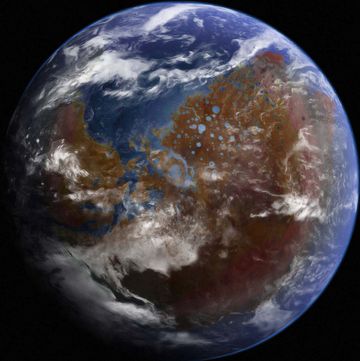(even if you aren't vegan)
Leviathan/places/Mars
Mars is the fourth planet from the Sun in it's solar system and it's second most populated planet, next to Earth. Mars is sometimes nicknamed as the "Red Planet" because of its reddish appearance, due to the large amounts of Iron Oxide that lie on its surface.
History
For centuries of human existence, the idea of leaving the atmosphere was considered absurd, let alone the idea of visiting a planet that was millions of miles away. Plus, even if reaching Mars was possible, we couldn't live there, right? Wrong.
In 2043, after years of petty squabbling between the United States and The New Republic of China, the two countries made an agreement that would not only cement their friendship for years to come, but also shape the course of history completely. The two nations agreed to work together on a space program that would allow the human race to not only visit Mars, but to change its entire atmosphere and colonize it too. After half a century of constant research and scouting missions, they had finally succeeded. Mars was suitable enough to support life on its own accord.
For the decades that followed, more and more Earthlings migrated to Mars and helped it develop. Through these efforts, Mars soon became the first "planet nation", giving birth to its own separate economy, and creating a new culture altogether as well. One that started off with Earthly origins, but ended up being something of itself.
Physical characteristics
Mars has approximately half the radius of Earth. It is less dense than Earth, having about 15% of Earth's volume and 11% of the mass. Its surface area is only slightly less than the total area of Earth's dry land. For a long time, the planet was devoid of water on the surface, with only trace amounts being found. But due to Terraforming efforts by the humans, this is no longer the case. Over a third of the planet's surface happens to be ocean. The dry land that remains happens to form a massive supercontinent, with a massive archipelago of islands surrounding it.
Climate
Mars's seasons are the most Earth-like, due to the similar tilts of the two planets' rotational axes. However, the lengths of the Martian seasons are about twice those of Earth's, as Mars’ greater distance from the Sun leads to the Martian year being about two Earth years in length. Martian surface temperatures vary from lows of about −140 °C (−220 °F) during the polar winters to highs of up to 20 °C (68 °F) in summers. The wide range in temperatures is due to the thin atmosphere which cannot store much solar heat, the low atmospheric pressure, and the low thermal inertia of Martian soil.
Moons
Mars has two tiny natural moons, Phobos and Deimos, which orbit very close to the planet and are thought to be captured asteroids. From the surface of Mars, the motions of Phobos and Deimos appear very different from that of the earth's moon. Due to human colonization, the two moons now serve as bases for atmosphere generators.
Life on Mars
Due to the Terraforming efforts by the original human colonizers, life on Mars is not unlike that of day-to-day life on Earth. The two most spoken languages of Mars happen to be English, followed incredibly closely by Chinese. Other languages are spoken regularly too, but on a much minor level compared to these two. The capital city of Mars is Romulus, and their official currency is the "Shoumei".
